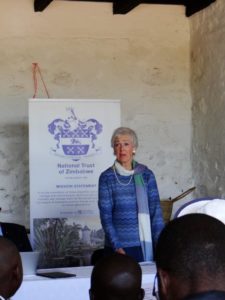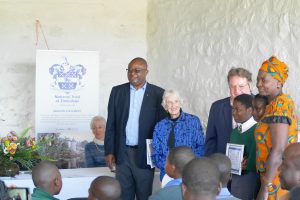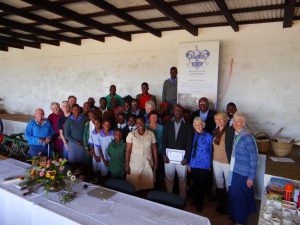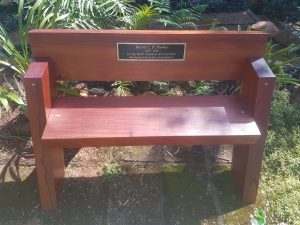I wish to extend my appreciation to Mrs Merle Moore (Vice Chairman), Mr Geoff Hawksley (Treasurer), Mr Marshall Nyanhanda (Curator) and all Committee Members – past and present – for efficiently maintaining the smooth running of the museum.
The display depicting the history of the Nyanga Churches and Missions was slowly expanded and improved, with further research undertaken and photographs added.
It is the intention of the Committee to undertake Heritage projects whenever possible. In 2018 we were invited to join with Uganda and Sierra Leone in an INTO cross-border competition which encouraged children to question and do research into customs and traditions. It would be almost impossible to organise a project such as this in the Nyanga area without a ‘liaison officer’ who is in contact with every school. We are most fortunate to have as an ex-officio member, Mr W Dhlandhlara (SOLON Foundation), who fills this position for us, and enabled us to participate in this project.


Pupils from the Heritage Clubs were encouraged to create a short video depicting their chosen subject, using a cell-phone. Some worked in groups and others individually. The videos were judged initially by a local panel and the best submitted to a panel of school children. The three videos with the most votes were submitted to the INTO group. The best videos were shown at a Prize-Giving Event organised by Mrs Moore and Mr Dhlandhlara.


Welcome speeches
Mr W Dhlandhlara Mrs M Moore, Vice Chair
NTZ and SOLON funded the lunches and Mrs Waterworth organised the certificates. There were monetary prizes which went to the Heritage Clubs, and three individual prizes. Our gratitude goes to INTO, the teachers involved, Curator, the judges and committee members and to NTZ Councillors who attended the event.


First prize: St Monica’s School with Mr Dhlandhlara, Mrs E.A Logan Chair, Mr D Scott Executive Chair
Second prize: Nyatate School
Proud Runners up



Mrs Waterworth, Executive Vice Chair, then presented three educational
books  that were very kindly donated by the Solon Foundation.
that were very kindly donated by the Solon Foundation.
Following the lecture and journey of exploration in 2017 to Nyanga North to visit the homes of early Nyanga Sculptors by Dr Jonathan Zilberg, (Associate Research and Scholar for African Studies), the family of the late Jonathan Matimba offered Jonathan’s work to RNHE for display. Dr Zilberg and Rob Burrett assisted with the funding of the project and the works of art were transported to the museum in August. This culminated in an Open Day and Exhibition of the works of Jonathan Matimba and local sculptors, who were given the opportunity of displaying their work at the exhibition; some sales were made. Dr Zilberg spoke to the large gathering of visitors and artists on Nyanga’s early sculptors, explaining different styles, materials and techniques. The Committee is now discussing how the widow of Jonathan Matimba can receive some reward for the loan of the works of art. Dr Zilberg presented RNHE with one of the wooden sculptures – The Yawn Dog. A professional video has been compiled by Iain Macdonald as a valuable record of this important event.
Dr Ines Grainger donated the funds for a new sign for the door of the Grainger Room to commemorate the 100th Anniversary of the birth of Don Grainger. A summary of the life of Don Grainger was printed in the John Galt Gazette. This excellent local publication advertises free of charge, monthly news from RNHE and articles of general interest re recent displays, etc.
The Curator and Student on attachment have updated the inventory documentation and donation records on the computer. They have prepared most books in the Grainger Reading Room for cataloguing; this project needs to be completed and students encouraged to make use of the excellent collection of books for research purposes.
As public interest increases in the museum, so does our opportunity of spreading information and helping to make the world a better place! Mrs Matimba was given a wheel-chair from Rotary, through Council member Clare Peech, as a result of the sculpture exhibition.
Dr Ines Grainger donated copies of her Women’s Club recipe books to a club organiser in Harare who visited RNHE, for use by her members.
Rob Burrett’s historic booklets have become ‘best sellers‘ from the museum shop, with some visitors asking for the latest publication to add to their collection. Rob has also written an excellent booklet for schools on Rock Art, funded by the French Ministry of Foreign Affairs, particularly for the Mukuvisi Wooklands Environmental Project. 400 copies were given for distribution to Nyanga Schools.
As a result of our enquiries and research into the history of the Dutch Settlement, an excellent illustrated document has been written by someone who grew up in that area in the 50s/60s, which can now be used for information on this previously un-documented area and era of Nyanga’s history.
Visitors have requested more information on the Natural History of Nyanga, and the Committee is planning a display to depict this.
As a grand finale to our year, we moved, with great difficulty, a Portable Steam Engine donated by Aubrey Logan, from Juliasdale to RNHE, with the assistance of Mr Steve Lapham, Mr Sibanda of National Parks and his tractor driver, the Curator and a number of good, strong men! The renovated and painted Engine (exported from UK to SA in 1903 and pulled by oxen to Bindura district in 1904) is happily settled in the Wagon Shed, next to the Ox Wagon.


Good wishes go to Marshall Nyanhanda with his studies by correspondence for a Bachelor of Science honours degree in Development Studies – under the Faculty of Social Sciences. We have enjoyed the company of our student on attachment Meshullam Mudzedze, and will miss her presence at the museum. She has worked well and matured in confidence over the past ten months, and we wish her well as she continues with her studies in Archaeology, Museum and Heritage Studies.
Our thanks go to Management and Staff of Rhodes Hotel for their support of all our projects and for generously lending their cups, urns and chairs for functions. The Hotel also accommodates the Curator and his family, for which we are most grateful.
To David Scott, Sharon Waterworth and the members of the NTZ Council, our thanks for your continued support and advice. Our thoughts are with Mrs. Helen Hyslop as she struggles with health issues. Helen advised and encouraged us through those first difficult years, and we miss the contact with her.
In stepping down as Chair, my very best wishes for the future go to the new Committee of the RNHE, may you gain as much enjoyment and satisfaction from your museum work as have Aubrey and I !
Edone A Logan, Chair, April, 2019
Footprints: I am indeed awed by what Edone, first Chairperson of RNHE, and Aubrey Logan and their successive committees and donors have achieved to make such a remarkable museum. The RNHE is the only NTZ museum in the country: it is our duty to maintain and develop it as a unique showpiece.
The present path: Numerous donations have graced our shelves, floors, nooks and crannies over the past year: the Punch Library of Humour from Merle Moore and her late husband Nigel; a 170-year-old executive desk first owned by Sir Benjamin Greenacre, Mayor of Durban, and latterly by his (recently late) great-grandson John, from whose collection of 18 exquisite chess sets a fascinating African one, made of intricately-crafted wire, was chosen for the Museum. The magnificent, wondrously carved ‘Greenacre desk’ now serves proudly as our grand Reception desk.
Much care has been taken into rejuvenating our small entrance garden, litter collection, labels and signs, and the Curator’s unsolicited restoration of wooden railings all add to a positive ambience and attract favourable response.
Hearty tribute is due to our small, determined and enthusiastic committee for their constructive ideas, practical input and generously-given time over this past year. We have been delighted to welcome Nyasha Makanza – Manager of Rhodes Hotel to our ranks.
Challenges: The shortages of fuel and rapid decline in value of our local currency over the past year have had a catastrophic impact on our attendance levels, particularly by school parties: schools (and parents) have to budget for ‘outings’ and educational trips well in advance but, by the time they arrive, our very modest entrance fees have become unaffordable for them and we do not have the heart to turn them away.
To be of real use and amongst the greatest of such needs is to be educational. To be of educational value – to old and young – means more than being merely ‘fascinating’ or cluttered. In numerical terms the vast majority of our visitors are young people, eager to be captivated and to learn. We must grasp and build on this educational opportunity within this Museum, as an adjunct to the international award-winning outreach already achieved, led so commendably by Edone Ann Logan and her assistants.
Needs: A Regional Information Centre. A small 50-seater lecture/video-theatre, of simple construction and comfortably appointed with carpeted steps and a large flat-screen TV for chool children, public lectures and functions. This is something we believe we now need and it’s appropriately educational! Relevant material has already been researched and prepared.
Two other needs are the resurfacing of the Shed’s floor, and replacement of outside steps up to the loft.
Projects: We are planning a new brochure – one which we hope will ‘capture’ people irresistibly. With this in mind, we have had a lot of photographs taken professionally both in, and of, the Museum – photographic ‘hints’ of what is to be found here.
Something we are striving for in Rhodes Museum is to achieve a balance in what we display. It is important that we portray significant players and events in our history from Lobengula to Tangwena, from Welensky to Mugabe, from the Mashona rebellion to the liberation struggle – all as part of the boundaries laid down by Rhodes 130 years ago. We have been awakened to this need, surprisingly, by children visiting the Museum who say, “Who were the people ruling this country before Independence in 1980? We want to see them and know about them, too.” Boundless scope here for additions to the informative Time Line already set up – and for our video theatre!
The Nyanga region is home to a variety of creative crafts-people: here are to be found wood-carvers, sculptors, weavers, nurserymen and furniture-makers. One of our projects is to give such people the greater exposure they deserve, by holding on-site ‘Craft Days’ over public holidays when visitors can see them at work (and hopefully buy).
One aspect of Nyanga’s history which has been largely overlooked by our Museum is the “Old Dutch Settlement” of Nyanga North, dating from more than a century ago. We mustn’t allow this significant part of our local history to slip into oblivion.
Finally, we here in Nyanga live in a paradise of wild flowers. One of our hopes is to celebrate this natural beauty, in Rhodes Museum, by displaying copies of Mary Clarke’s comprehensive and meticulous paintings of local indigenous flowers – perhaps those relevant to each month.
GUY CARY, Chair, 2019-2020








































 USE NUMBER: 0775 907 595
USE NUMBER: 0775 907 595